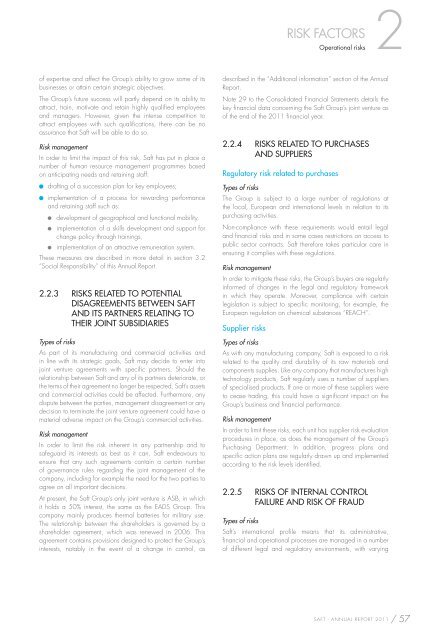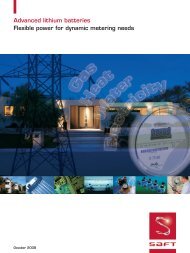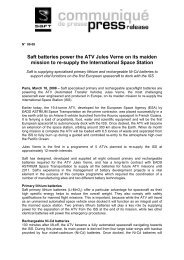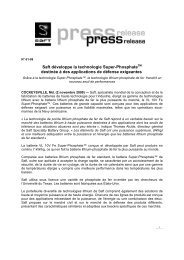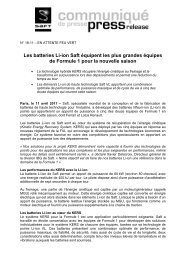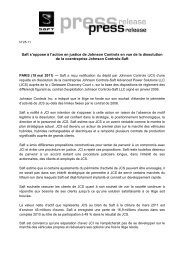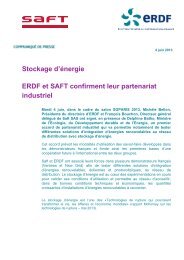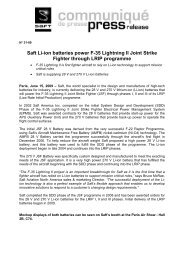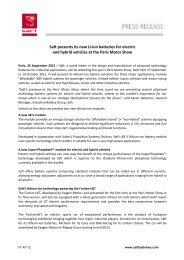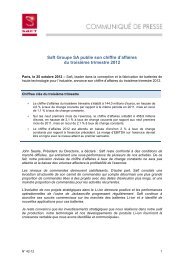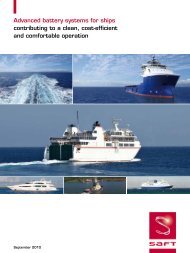ANNUAL REPORT 2011 REGISTRATION DOCUMENT - Saft
ANNUAL REPORT 2011 REGISTRATION DOCUMENT - Saft
ANNUAL REPORT 2011 REGISTRATION DOCUMENT - Saft
You also want an ePaper? Increase the reach of your titles
YUMPU automatically turns print PDFs into web optimized ePapers that Google loves.
of expertise and affect the Group’s ability to grow some of its<br />
businesses or attain certain strategic objectives.<br />
The Group’s future success will partly depend on its ability to<br />
attract, train, motivate and retain highly qualifi ed employees<br />
and managers. However, given the intense competition to<br />
attract employees with such qualifi cations, there can be no<br />
assurance that <strong>Saft</strong> will be able to do so.<br />
Risk management<br />
In order to limit the impact of this risk, <strong>Saft</strong> has put in place a<br />
number of human resource management programmes based<br />
on anticipating needs and retaining staff:<br />
� drafting of a succession plan for key employees;<br />
� implementation of a process for rewarding performance<br />
and retaining staff such as:<br />
� development of geographical and functional mobility,<br />
� implementation of a skills development and support for<br />
change policy through trainings,<br />
� implementation of an attractive remuneration system.<br />
These measures are described in more detail in section 3.2<br />
“Social Responsibility” of this Annual Report.<br />
2.2.3 RISKS RELATED TO POTENTIAL<br />
DISAGREEMENTS BETWEEN SAFT<br />
AND ITS PARTNERS RELATING TO<br />
THEIR JOINT SUBSIDIARIES<br />
Types of risks<br />
As part of its manufacturing and commercial activities and<br />
in line with its strategic goals, <strong>Saft</strong> may decide to enter into<br />
joint venture agreements with specifi c partners. Should the<br />
relationship between <strong>Saft</strong> and any of its partners deteriorate, or<br />
the terms of their agreement no longer be respected, <strong>Saft</strong>’s assets<br />
and commercial activities could be affected. Furthermore, any<br />
dispute between the parties, management disagreement or any<br />
decision to terminate the joint venture agreement could have a<br />
material adverse impact on the Group’s commercial activities.<br />
Risk management<br />
In order to limit the risk inherent in any partnership and to<br />
safeguard its interests as best as it can, <strong>Saft</strong> endeavours to<br />
ensure that any such agreements contain a certain number<br />
of governance rules regarding the joint management of the<br />
company, including for example the need for the two parties to<br />
agree on all important decisions.<br />
At present, the <strong>Saft</strong> Group’s only joint venture is ASB, in which<br />
it holds a 50% interest, the same as the EADS Group. This<br />
company mainly produces thermal batteries for military use.<br />
The relationship between the shareholders is governed by a<br />
shareholder agreement, which was renewed in 2006. This<br />
agreement contains provisions designed to protect the Group’s<br />
interests, notably in the event of a change in control, as<br />
2<br />
RISK FACTORS<br />
Operational risks<br />
described in the “Additional information” section of the Annual<br />
Report.<br />
Note 29 to the Consolidated Financial Statements details the<br />
key fi nancial data concerning the <strong>Saft</strong> Group’s joint venture as<br />
of the end of the <strong>2011</strong> fi nancial year.<br />
2.2.4 RISKS RELATED TO PURCHASES<br />
AND SUPPLIERS<br />
Regulatory risk related to purchases<br />
Types of risks<br />
The Group is subject to a large number of regulations at<br />
the local, European and international levels in relation to its<br />
purchasing activities.<br />
Non-compliance with these requirements would entail legal<br />
and fi nancial risks and in some cases restrictions on access to<br />
public sector contracts. <strong>Saft</strong> therefore takes particular care in<br />
ensuring it complies with these regulations.<br />
Risk management<br />
In order to mitigate these risks, the Group’s buyers are regularly<br />
informed of changes in the legal and regulatory framework<br />
in which they operate. Moreover, compliance with certain<br />
legislation is subject to specifi c monitoring, for example, the<br />
European regulation on chemical substances “REACH”.<br />
Supplier risks<br />
Types of risks<br />
As with any manufacturing company, <strong>Saft</strong> is exposed to a risk<br />
related to the quality and durability of its raw materials and<br />
components supplies. Like any company that manufactures high<br />
technology products, <strong>Saft</strong> regularly uses a number of suppliers<br />
of specialised products. If one or more of these suppliers were<br />
to cease trading, this could have a signifi cant impact on the<br />
Group’s business and fi nancial performance.<br />
Risk management<br />
In order to limit these risks, each unit has supplier risk evaluation<br />
procedures in place, as does the management of the Group’s<br />
Purchasing Department. In addition, progress plans and<br />
specifi c action plans are regularly drawn up and implemented<br />
according to the risk levels identifi ed.<br />
2.2.5 RISKS OF INTERNAL CONTROL<br />
FAILURE AND RISK OF FRAUD<br />
Types of risks<br />
<strong>Saft</strong>’s international profi le means that its administrative,<br />
fi nancial and operational processes are managed in a number<br />
of different legal and regulatory environments, with varying<br />
SAFT - <strong>ANNUAL</strong> <strong>REPORT</strong> <strong>2011</strong> / 57


